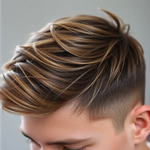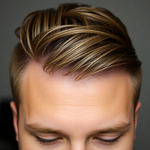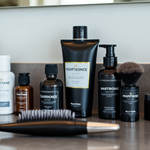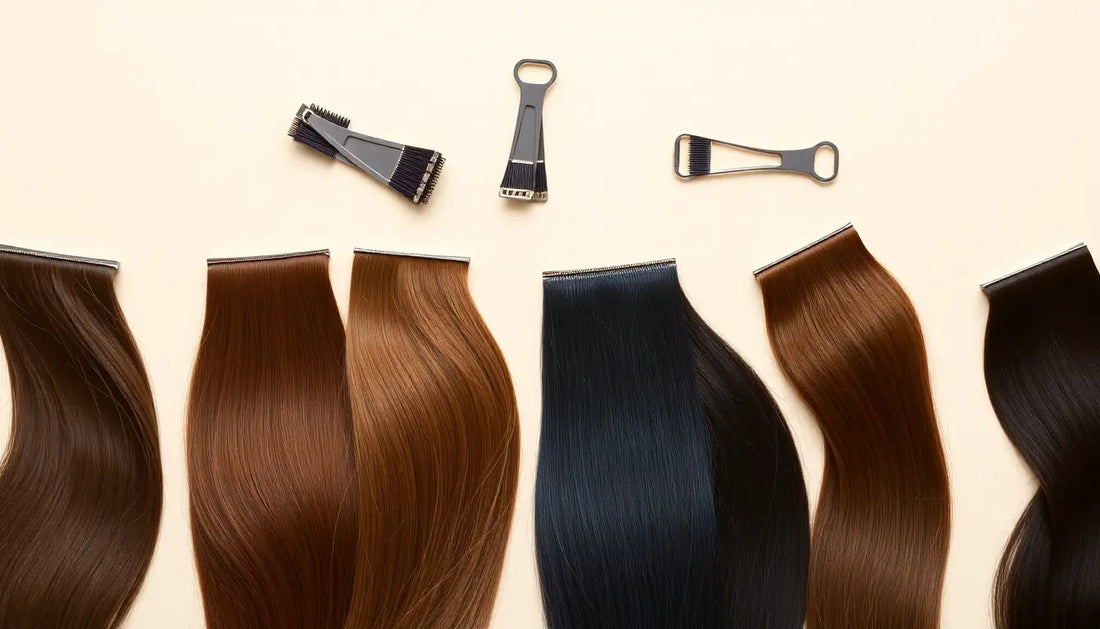
Build a Hair Shade Swatch Kit: Use Semi‑Permanent Color to Coordinate and Extend Your Men's Capsule Wardrobe
17 October 2025
Share
Build a Hair Shade Swatch Kit: Use Semi‑Permanent Color to Coordinate and Extend Your Men's Capsule Wardrobe
Struggling to keep your look sharp while keeping outfit choices simple? Build a Hair Shade Swatch Kit: Use Semi‑Permanent Color to Coordinate and Extend Your Men's Capsule Wardrobe — a practical system that helps you match hair tone to clothes, season, and occasion without committing to permanent dye. This guide walks you through building, testing, documenting, and using a swatch kit that saves time and levels up your capsule wardrobe.
Why a Hair Shade Swatch Kit Works for a Men's Capsule Wardrobe
A capsule wardrobe is all about reducing friction: fewer pieces, better outcomes. Your hair is another finishing touch in that system. A compact swatch kit built with semi‑permanent color gives you low-commitment options to tweak tone, boost contrast, and refresh outfits. Instead of a closet full of clothes to change your vibe, you get a handful of hair tones to alter the whole look.
What is Semi‑Permanent Color and Why Use It?
Semi‑permanent hair color deposits pigment without permanently altering the hair's underlying structure. It fades gradually (typically 4–12 washes) and is generally gentler than permanent dye. For men who want flexibility—seasonal tweaks, trialing a shade for an event, or testing what works with their wardrobe—semi‑permanent color is ideal.
Advantages:
- No long-term commitment — easy to switch or fade out.
- Less likely to create stark root lines like permanent dye.
- Often ammonia-free and less damaging; options available in eco-friendly formulas.
- Great for blending, enhancing natural tones, and adding subtle warmth or ash.
Supplies: Your Swatch Kit Shopping List
Start small and expand as you learn. Here's a checklist to build an effective swatch kit.
- 4–8 semi‑permanent colors in small tubes or sachets (choose a range: cool, neutral, warm, darker intensity).
- Remy hair swatches or clip-in extension samples in 2–3 natural base shades (light brown, medium brown, dark brown/black).
- Disposable gloves, fine application brush, and single-use dye bowls.
- Waterproof labels, permanent marker, and small resealable bags or a flat swatch binder.
- Camera or smartphone, neutral background card (gray or white), and a small LED daylight panel (optional).
- Small jars or bottles to premix custom shades and a logbook (digital or paper) for notes.
Step-by-Step: Build Your Hair Shade Swatch Kit
- Pick a starting palette. Aim for 4 shades: your natural base, one cooler (ash), one warmer (chestnut), and one darker/deeper shade. These cover most match needs and let you experiment with tone and contrast.
- Buy or cut swatches. Purchase Remy sample strips or order 4–6 clip-in samples. If you cut your own, ensure clean, straight ends and label each base color.
- Set up a test station. Work on a washable surface. Keep a neutral background for photos and consistent lighting. Natural daylight is best for color accuracy; use LED daylight bulbs indoors.
- Patch-test products. Always perform a skin patch test 48 hours before using any hair color on skin. For detailed guidance on safety, see the American Academy of Dermatology: AAD: Hair Dye Safety.
- Apply color to swatches. Follow the product instructions for processing time. Keep notes for each application: brand, shade code, developer (if used), time, water temp, and aftercare.
- Document results. Photograph swatches after processing and after rinsing/drying. Take shots in daylight, warm indoor light, and against a dark fabric to see contrast. Save images with filenames like "ash-01-daylight-01.jpg" for organization.
- Label, store, and log. Attach waterproof labels to each physical swatch with all product details and a short note on fade after 1–5 washes. Keep a digital spreadsheet with photos, notes, and outfit pairings that worked well.
How to Photograph Swatches for Reliable Color Matching
- Use a neutral background card and consistent distance/angle.
- Photograph in natural light near a window for the most accurate color rendering.
- Include a small neutral gray or white card in the frame for color correction.
- Take close-ups and wider shots with an outfit fabric sample next to the swatch to visualize match.
Mixing and Custom Shades: Simple Recipes
Once you have basics, you'll want to blend. Semi‑permanent colors often mix well without developer. Keep records of ratios in your logbook.
- Cool-down mix: 3 parts natural brown + 1 part ash to neutralize warmth.
- Warm boost: 4 parts natural brown + 1 part warm chestnut for subtle warmth.
- Deepen without draining shine: 2 parts natural brown + 1 part deep espresso.
Always test mixes on a swatch before applying to hair. Write exact ratios and processing time on the swatch label.
How to Use Your Swatch Kit to Coordinate Outfits (Practical Rules)
Here are simple rules to translate swatch info into daily outfit choices:
- Contrast is king. If you wear darker clothes, a slightly lighter or warmer hair tone adds dimension. If your outfit is light and neutral, a darker hair tone grounds the look.
- Consider undertones. Warm clothing (camel, tan, olive) pairs best with warm hair tones (chestnut, warm medium brown). Cool clothing (navy, gray, black) pairs well with ash or neutral shades.
- Use seasonal shifts. Cooler hair tones for spring/summer and warmer tones for fall/winter help your overall aesthetic stay seasonally consistent.
- Match intensity, not exact color. Avoid trying to match hair to fabric exactly. Match intensity and temperature (warm/cool) instead.
Styling Scenarios: Real-World Examples
These scenarios show how a swatch kit creates fast wins.
- Young Professional Interview: Outfit: navy blazer + light gray trousers. Swatch: cool ash-brown keeps the look modern and professional — avoids warm tones that can read casual.
- Weekend Date: Outfit: olive bomber + white tee. Swatch: warm chestnut adds approachable warmth and enhances olive undertones.
- Creative Pitch: Outfit: black denim, textured knit. Swatch: soft ash with a slight contrast adds edge without looking like you tried too hard.
- Summer Vacation: Outfit: linen shirt, tan shorts. Swatch: light golden-brown adds sun-kissed harmony with linen and tan tones.
Maintenance: Keep Color and Clothes Looking Great
- Use sulfate-free shampoo and wash with cool water to preserve semi‑permanent color longer.
- Avoid daily hot showers for faster fading; rinse hair in cooler water when possible.
- Keep a small touch-up kit for roots: a bottle of your chosen shade and an application brush for quick fixes.
- Store your swatches away from direct sunlight to prevent visual fading of your reference samples.
Troubleshooting Common Issues
- Color looks too warm: Mix a small portion of ash into the next application and test on a swatch first.
- Color fades too fast: Switch to a more pigmented semi‑permanent line or reduce shampoo frequency. Note porosity: porous hair holds dye differently; use color-depositing conditioners to extend tone.
- Uneven results: Check application technique, saturation, and processing time. Always apply evenly and fully saturate swatches when testing.
Safety, Ingredients, and Sustainability
Even semi‑permanent dyes can cause allergic reactions — always patch test. If sustainability matters to you, look for ammonia-free, cruelty-free, and recyclable packaging options. Menll.com emphasizes quality and responsible sourcing in its product collections; for eco-conscious grooming tools, see Menll.com Grooming Collection: Menll.com Grooming Collection.
For more on dye safety and what to watch for, check WebMD's overview of hair dye risks: WebMD: Hair Dye Risks.
Build a Hair Shade Swatch Kit: Use Semi‑Permanent Color to Coordinate and Extend Your Men's Capsule Wardrobe
This is your actionable mantra. Repeat it when testing new shades or curating outfit pairings. Treat the swatch kit like a wardrobe instrument: organized, accessible, and helpful in making quick, confident choices.
Advanced Tips: Elevating the System
- Create outfit cards. For each swatch, create a digital card that pairs swatch photos with 3 favorite outfits and notes (best season, level of formality, and recommended shampoo).
- Use extensions for non-dye days. For nights out or photo shoots, clip in a swatch-matched extension for instant effect without re-dyeing.
- Track fading data. After each application, mark how the shade changed after 1, 3, and 7 washes. This helps predict lifespan and plan touch-ups.
- Coordinate with facial hair. If you have a beard, test how beard and hair tones read together. Sometimes a slightly different beard tone adds character; other times, a matched approach is cleaner.
Cost, Time, and ROI
Initial kit costs are modest: small tubes and sample swatches typically total $40–$120 depending on brands. Time investment: one or two 90-minute sessions to set up and document. The ROI is high: fewer impulse buys, smarter outfit choices, and a more cohesive personal style that saves time and boosts confidence.
Common Questions (FAQ)
- How many swatches should I keep? 8–12 physical swatches and a digital folder with 30–40 photos is a solid starter kit.
- Can I DIY everything? Yes — the swatch approach is designed for at-home experimentation. For full-head color changes, book a pro consult first.
- Will semi‑permanent color damage my hair? Its gentler than permanent dye but still introduces pigments. Choose gentle formulas and condition regularly.
- How do I choose shades for different skin tones? Consider skin undertone: cool skin tones suit ash/neutral shades; warm undertones pair with chestnut and golden hues. Use swatches to confirm in person.
Final Checklist: Your First Swatch Session
- Pick 4 initial shades and 2 base swatches.
- Set up lighting and camera, collect materials.
- Patch test products 48 hours ahead.
- Apply, document, photograph, and label.
- Store swatches and log notes in a single folder or binder.
Conclusion and Soft CTA
Building a hair shade swatch kit is a low-risk, high-reward move for any man curating a capsule wardrobe. It reduces decision fatigue, helps you test looks for different seasons and occasions, and keeps your style intentional. Which shade will you test first? Share your experiment in the comments below, or browse Menll.com for grooming essentials and wardrobe foundations to match your new look: Menll.com Outerwear.
Prev post
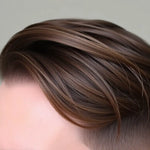
Step-by-Step Semi-Permanent Hair Color System to Multiply Looks from a Minimal Men's Capsule Wardrobe
Updated on 18 October 2025
Next post

Semi-Permanent Hair Color: Shade Anchors That Replace Extra Pieces in a Minimal Men's Capsule Wardrobe
Updated on 16 October 2025


